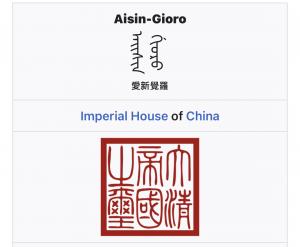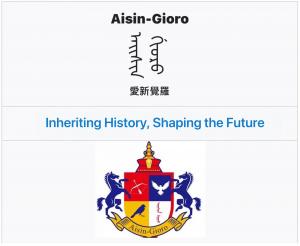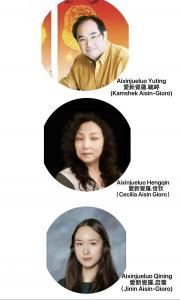Imperial Descendants, Three Generations, One Vision: The Founding Story of the Aisin Gioro International Art Prize

The Aisin-Gioro family emblem (in Manchu script) alongside the Great Qing Imperial Seal symbolizes the lineage’s historical continuity and its transformation from imperial heritage to contemporary cultural expression.
Founded by three generations of China’s last imperial family, the Aisin Gioro International Art Prize bridges heritage and contemporary art on a global stage
Created by descendants of China’s last imperial family, the prize represents the continuation of cultural memory through artistic renewal — a bridge between heritage and innovation.
From Empire to Exile: A Family’s Transformation
The Aisin Gioro family, the last imperial lineage of China, traces its origins to the Jurchen peoples of Northeast Asia.
Before 1644, the family ruled independently in the northeast under the Later Jin (1616–1636) and Great Qing (1636–1644) dynasties.
In 1644, Qing forces entered China proper and established a new imperial dynasty that ruled until 1912. Under Qing rule, the empire expanded to an unprecedented scale, incorporating Xinjiang, Tibet, Mongolia, and Taiwan into a unified imperial framework — laying the foundation for China’s modern borders.
In 1912, Empress Dowager Longyu signed the abdication decree on behalf of the two-year-old Emperor Puyi, marking the end of imperial rule.
The agreement granted the royal family symbolic status and residence rights, but these were soon revoked.
Puyi — uncle of Kamshek (Aixinjueluo Yuting), great-uncle of Cecilia (Aixinjueluo Hengqin), and great-great-uncle of Jinin (Aixinjueluo Qining) — was eventually expelled from the Forbidden City.
Years later, the family led its final regime, Manchukuo (1932–1945) — often described as a puppet state, yet viewed by some as a complex attempt to reclaim ancestral sovereignty in Northeast Asia.
That turbulent period, followed by political upheaval and the Cultural Revolution, marked decades of displacement and loss for Aisin Gioro descendants.
To survive, the family underwent a profound transformation of identity — from royalty to civilians.
They laid aside titles and turned to education, literature, and art as their means of continuity.
Culture became their dignity, their bridge between memory and modernity.
It was not a retreat but a conscious way of living without dishonor.
Over the past century, more than a hundred artists have emerged from the Aisin Gioro family — among them Pu Ru, Pu Quan, Qi Gong, Yuzhan, and Qixiang, now recorded in Chinese art history.
In modern generations, many family members emigrated abroad, and their descendants were born across the world.
Though the family name became globalized, its historical connection to China remains unbroken.
Art as Memory and Renewal
For the prize’s founders, the Aisin Gioro name should not remain a relic of the past but evolve into a living voice — one that continues to create, adapt, and speak across cultures.
The prize does not seek nostalgia or prestige; it seeks to make art a space of rebirth — across history, identity, and fracture.
“Every generation must find its own language to express remembrance,” said Cecilia Aisin Gioro, Co-Founder and Chief Planner of the prize.
“By announcing the award during the Qingming Festival — a time when we honor the past while welcoming spring’s renewal — we hope to transform memory into creation.”
History, Cecilia explained, is composed of time itself, while art is a way of layering and recording it.
When creation moves in rhythm with nature, artists rediscover the essence of the continuity of life in Chinese agrarian philosophy.
Through this rhythm, the prize invites artists worldwide to feel the living renewal of Chinese culture.
A Bridge Between Heritage and Innovation
The Aisin Gioro International Art Prize transforms cultural timekeeping into artistic structure.
Its schedule follows the 24 Solar Terms — an ancient Chinese system recognized by UNESCO as Intangible Cultural Heritage.
Key terms such as Grain Rain (谷雨), Great Heat (大暑), Frost’s Descent (霜降), and Major Cold (大寒) mark its progression — from submissions to jury deliberation and award ceremonies.
Each year’s winning works are preserved in the Aisin Gioro Art Annual, produced as a handcrafted dragon-scale scroll — a rare Chinese binding technique that emerged in the Tang dynasty.
This process includes over ten steps — printing, folding, arranging, and mounting — combining ancient craftsmanship with contemporary design.
Each anthology carries an ISBN and is distributed as a non-commercial archive to major museums, libraries, and universities worldwide.
A Family of Continuity
The prize was co-founded by three generations of the Aisin Gioro family:
Aixinjueluo Yuting (Kamshek), cultural elder and guiding figure;
Cecilia Aisin Gioro (Hengqin), chief planner and organizer; and
Aixinjueluo Qining (Jinin), the youngest co-founder who initiated the youth divisions.
Together, their roles represent continuity across generations, weaving inheritance with innovation.
“History is part of time itself,” Cecilia reflected.
“Art is how we record and transform that time. When creation aligns with nature, we rediscover the meaning of life’s renewal.”
Through this vision, the Aisin Gioro International Art Prize becomes more than an award — it is an act of remembrance, a platform of creation, and a dialogue between past and future.
Contact: press@aisingioroartprize.com
Website: www.aisingioroartprize.com
Issued by the Aisin Gioro International Art Prize Committee
Aisin Gioro Arts & Cultural Heritage Society, Vancouver, Canada
Xuanzi
AG NEWS
+1 604-764-6665
email us here
Legal Disclaimer:
EIN Presswire provides this news content "as is" without warranty of any kind. We do not accept any responsibility or liability for the accuracy, content, images, videos, licenses, completeness, legality, or reliability of the information contained in this article. If you have any complaints or copyright issues related to this article, kindly contact the author above.


